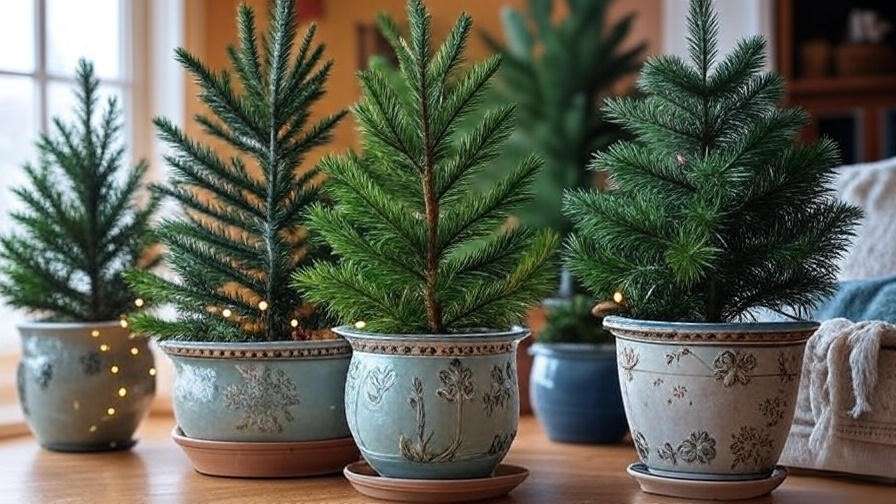Imagine bringing the serene beauty of a forest into your home with a vibrant potted pine tree! These charming evergreens are more than just holiday decor—they’re year-round companions that add life and freshness to any space. Whether you’re a plant enthusiast or a beginner, mastering the care of potted pine trees can transform your indoor environment into a cozy, green oasis. In this comprehensive guide, we’ll share expert-backed tips to help you grow and maintain healthy potted pine trees, ensuring they thrive indoors. With insights from horticulturists and trusted botanical sources, you’ll learn everything needed to keep your evergreen flourishing. Let’s dive in! 🌿
Section 1: Why Choose Potted Pine Trees? 🌿
The Appeal of Potted Pine Trees for Indoor Spaces
Potted pine trees are a fantastic choice for indoor plant lovers. Their lush, needle-like foliage brings a touch of nature to apartments, offices, or homes, creating a calming atmosphere. Beyond aesthetics, these evergreens offer functional benefits, such as mild air purification and a festive vibe that lasts beyond the holiday season. Unlike traditional houseplants, potted pine trees evoke a sense of timeless elegance, making them perfect for year-round decor. For urban dwellers with limited space, their compact size is a game-changer, fitting seamlessly on tabletops or corners.
Real-Life Example: Meet Sarah, a city apartment dweller who swapped her artificial Christmas tree for a potted Norfolk Island Pine. Not only did it serve as a sustainable holiday centerpiece, but it also became a permanent fixture in her living room, thriving with minimal care.
Types of Potted Pine Trees for Indoor Use
Not all pine trees are suited for indoor life, but several varieties excel in pots. Here’s a look at the most popular options:
- Norfolk Island Pine: Often mistaken for a true pine, this soft-needled beauty is a favorite for its Christmas tree-like appearance and manageable size (2–6 feet indoors).
- Dwarf Alberta Spruce: Compact and conical, this true spruce is ideal for small spaces, growing slowly to about 3–4 feet.
- Italian Stone Pine: With slightly longer needles and a rustic charm, this variety can reach 4–6 feet but adapts well to indoor conditions.
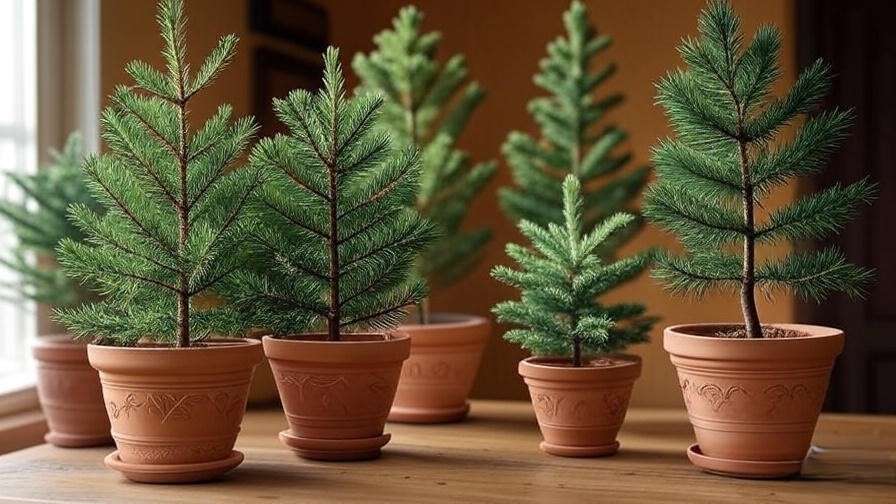
| Variety | Size (Indoor) | Light Needs | Care Difficulty |
|---|---|---|---|
| Norfolk Island Pine | 2–6 ft | Bright, indirect light | Easy |
| Dwarf Alberta Spruce | 3–4 ft | Bright, indirect light | Moderate |
| Italian Stone Pine | 4–6 ft | Bright, direct light | Moderate |
Tip: Choose a variety based on your space and lighting conditions. Norfolk Island Pines are best for beginners due to their forgiving nature.
Section 2: Setting Up Your Potted Pine Tree for Success 🌞
Choosing the Right Pot and Soil
The foundation of a healthy potted pine tree lies in its pot and soil. Select a pot with drainage holes to prevent waterlogging, as pine trees are sensitive to soggy roots. A pot 1–2 inches larger than the root ball allows room for growth without overwhelming the plant. Terracotta or ceramic pots are excellent for breathability, though plastic works if drainage is prioritized.
For soil, use a well-draining, slightly acidic mix (pH 5.5–6.5). A blend of potting soil, perlite, and sand mimics the natural conditions pine trees love. According to the University of Florida Extension, a mix of 60% potting soil, 20% perlite, and 20% coarse sand ensures optimal drainage and aeration.
Expert Insight: Test soil pH with a simple kit to confirm it’s within the ideal range for conifers. Adjust with sulfur if too alkaline.
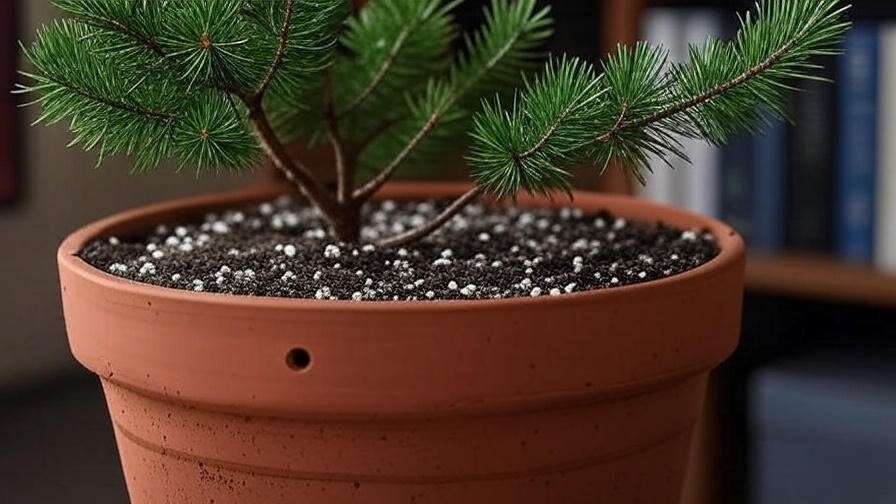
Ideal Placement and Lighting Conditions
Potted pine trees thrive in bright, indirect light, mimicking their natural forest understory habitat. Place your tree near an east- or west-facing window for 4–6 hours of filtered sunlight daily. If natural light is limited, supplement with a full-spectrum grow light (10,000–20,000 lumens) positioned 6–12 inches above the tree.
Common Mistake: Avoid placing your pine tree near heat sources like radiators or vents, as dry heat can cause needle drop. Rotate the pot every few weeks to ensure even light exposure and balanced growth.
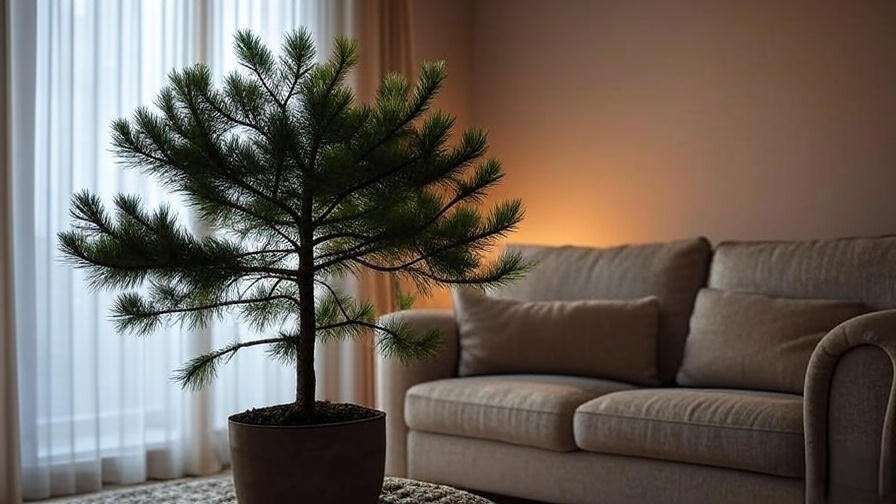
Section 3: Essential Care Tips for Potted Pine Trees 🪴
Watering and Humidity Needs
Proper watering is critical for potted pine trees. Keep the soil consistently moist but not waterlogged—check the top inch of soil; if it’s dry, it’s time to water. Use room-temperature water and pour slowly until it drains from the bottom. Overwatering is a leading cause of root rot, so ensure excess water escapes.
Indoor environments often lack the humidity pine trees crave (50–60% humidity). Increase moisture with a pebble tray filled with water or a humidifier near the plant. Misting the foliage 2–3 times weekly can also help, especially in dry winter months.
Pro Tip: In arid climates, group your potted pine with other plants to create a microclimate with higher humidity.
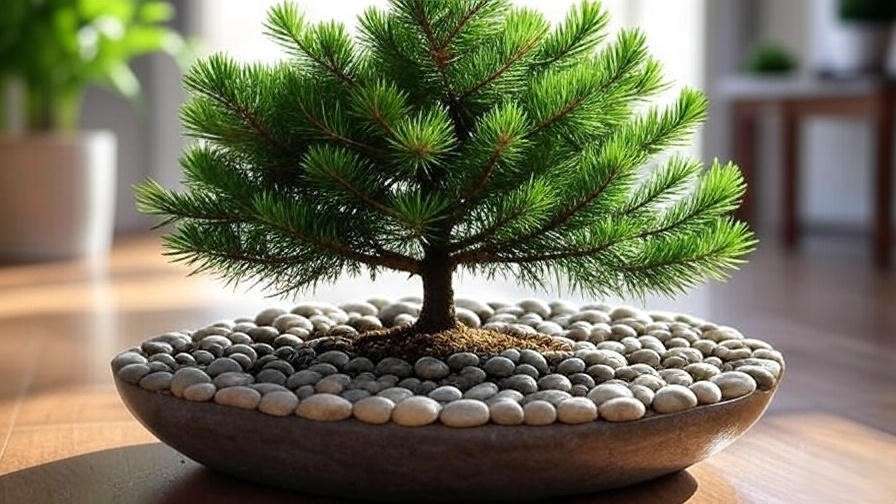
Fertilizing for Optimal Growth
Potted pine trees benefit from regular feeding during their growing season (spring to summer). Use a balanced liquid fertilizer (e.g., 10-10-10) diluted to half-strength, applied monthly. Avoid fertilizing in fall and winter when growth slows. Over-fertilization can burn roots, leading to yellowing needles, so watch for signs like crusty soil or wilting.
Warning: If needles turn yellow or brown after fertilizing, flush the soil with water to remove excess salts and pause feeding for a month.
Pruning and Shaping Your Pine Tree
Light pruning keeps your potted pine tree shapely and healthy. Use clean, sharp pruning shears to trim dead or overly long branches, focusing on maintaining a natural conical shape. For bushier growth, pinch back new growth tips in spring. Avoid heavy pruning, as pine trees don’t regenerate easily from old wood.
Step-by-Step Pruning Guide:
- Sterilize shears with rubbing alcohol.
- Identify dead or yellowing branches.
- Trim at a 45-degree angle just above a healthy node.
- Shape lightly to maintain symmetry.
- Dispose of clippings to prevent pest spread.
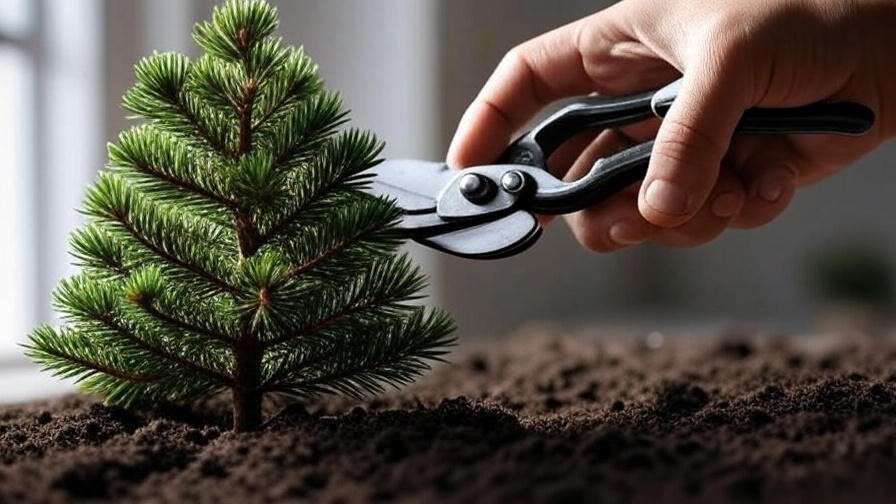
Section 4: Common Challenges and How to Solve Them 🛠️
Troubleshooting Potted Pine Tree Problems
Even with the best care, potted pine trees may face issues. Here’s a diagnostic checklist:
- Yellowing Needles: Often caused by overwatering, low light, or nutrient deficiency. Check soil moisture, increase light, and fertilize if needed.
- Needle Drop: Typically due to low humidity or sudden temperature changes. Boost humidity and avoid drafty spots.
- Stunted Growth: Indicates rootbound conditions or insufficient light. Repot or adjust lighting.
Expert Insight: The Missouri Botanical Garden recommends monitoring environmental changes to catch issues early. Keep a care journal to track watering, lighting, and symptoms.
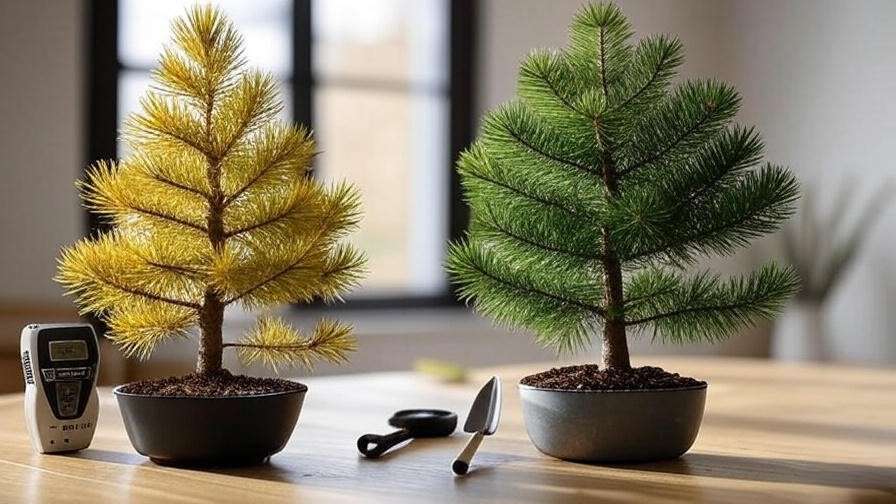
Pest and Disease Prevention
Common pests like spider mites and scale can target potted pine trees. Inspect foliage weekly for webbing, sticky residue, or tiny moving dots. Treat infestations with neem oil or insecticidal soap, applied every 7–10 days until pests are gone. Fungal issues, like root rot, arise from overwatering—ensure proper drainage to prevent them.
Pro Tip: Quarantine new plants for 2 weeks to avoid introducing pests to your potted pine.
Section 5: Seasonal Care and Long-Term Maintenance 🍂
Adapting Care for Seasonal Changes
Potted pine trees require tailored care as seasons shift to mimic their natural cycles. In spring and summer, their active growing period, ensure consistent watering and monthly fertilization to support new growth. Place them in bright, indirect light, but shield them from intense midday sun, which can scorch needles. If outdoor temperatures are mild (60–75°F), consider moving your pine to a shaded patio for a few hours daily to boost vitality.
In fall and winter, potted pine trees enter a dormant phase. Reduce watering to every 10–14 days, checking soil moisture to avoid overwatering. Indoor heating can dry out the air, so maintain humidity with a humidifier or pebble tray. If natural light dims, supplement with a grow light to provide 12–14 hours of illumination daily.
Seasonal Care Calendar:
| Season | Watering | Fertilizing | Lighting | Humidity |
|---|---|---|---|---|
| Spring | Weekly | Monthly | Bright, indirect | 50–60% |
| Summer | Weekly | Monthly | Bright, indirect | 50–60% |
| Fall | Every 10–14 days | None | Supplemental if needed | 50–60% |
| Winter | Every 10–14 days | None | Supplemental if needed | 50–60% |
Example: A reader in Chicago shared that using a grow light during winter kept their Dwarf Alberta Spruce vibrant, preventing needle drop despite short, cloudy days.
Repotting and Long-Term Growth
Repotting is essential for potted pine trees to prevent rootbound conditions and ensure long-term health. Repot every 1–2 years or when roots circle the pot’s interior (visible through drainage holes or stunted growth). Spring is the best time, as the tree is entering its growth phase.
How to Repot:
- Choose a pot 1–2 inches larger in diameter with drainage holes.
- Prepare a fresh, well-draining soil mix (60% potting soil, 20% perlite, 20% sand).
- Gently remove the tree, shaking off old soil and untangling roots.
- Place in the new pot, fill with soil, and water thoroughly.
- Keep in a shaded spot for 1–2 weeks to reduce transplant shock.
Tip: Watch a repotting tutorial from the Royal Horticultural Society for visual guidance on handling delicate roots.
Section 6: Creative Uses for Potted Pine Trees in Your Home 🎄
Styling and Decorating with Potted Pine Trees
Potted pine trees are versatile decor elements, adding charm to any room. Use them as table centerpieces, place them on a windowsill, or create a cozy corner display with multiple trees of varying sizes. Their evergreen foliage pairs beautifully with neutral or earthy-toned pots, complementing modern or rustic aesthetics.
For holiday flair, adorn your pine with lightweight, plant-safe decorations like mini fairy lights, wooden ornaments, or burlap ribbons. Avoid heavy ornaments that could damage branches or stress the tree.
Inspiration: A reader from Seattle shared a photo of their Norfolk Island Pine decorated with handmade paper stars, creating a minimalist yet festive look that garnered compliments all season.
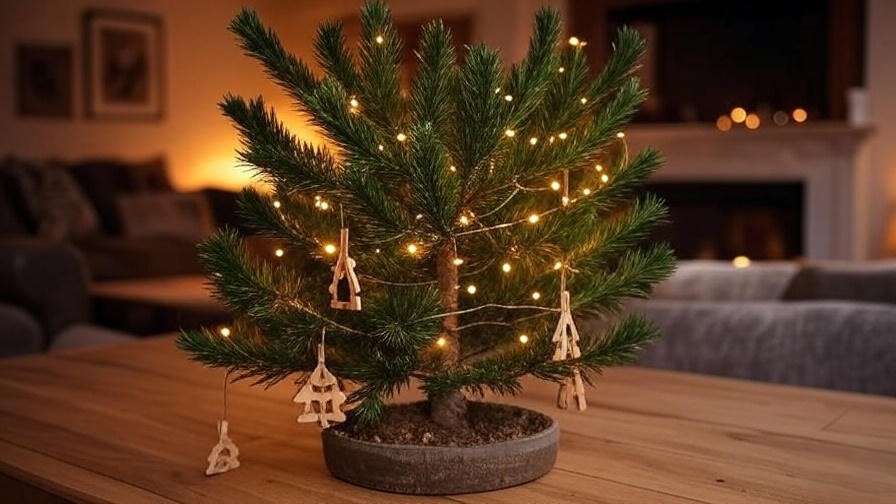
Sustainable Holiday Decor
Potted pine trees are an eco-friendly alternative to cut Christmas trees, reducing waste while adding lasting greenery to your home. Varieties like the Norfolk Island Pine shine as living holiday trees, easily transitioning to year-round houseplants. After the holidays, remove decorations and resume regular care to ensure longevity.
Case Study: The Johnson family in Portland switched to a potted Dwarf Alberta Spruce for their Christmas celebrations. After three years, the tree remains a thriving part of their living room, saving them money and reducing their environmental footprint.
Care Tip: Post-holiday, gradually reintroduce the tree to its normal light and watering routine to avoid stress from sudden changes.
Section 7: FAQs About Potted Pine Trees ❓
Q1: Can potted pine trees survive indoors year-round?
Yes, with proper care! Provide bright, indirect light, maintain humidity, and avoid overwatering. Norfolk Island Pines are particularly well-suited for year-round indoor growth.
Q2: How do I know if my pine tree is getting enough light?
Look for vibrant green needles and steady growth. If needles yellow or growth slows, move the tree to a brighter spot or use a grow light.
Q3: What should I do if my pine tree’s needles are turning brown?
Check for overwatering, low humidity, or insufficient light. Adjust care accordingly and trim affected areas to prevent spread.
Q4: Are potted pine trees safe for pets?
Most potted pine trees, like Norfolk Island Pines, are non-toxic to cats and dogs. However, ingesting needles may cause mild stomach upset, so keep trees out of reach.
Q5: How long can a potted pine tree live indoors?
With proper care, potted pine trees can live for several years, even decades. Regular repotting and consistent care are key to longevity.
Conclusion 🌳
Potted pine trees bring timeless beauty and a touch of nature to your indoor space, making them a rewarding addition for plant lovers. By following these expert-backed care tips—choosing the right pot and soil, providing adequate light and humidity, and troubleshooting issues—you can ensure your evergreen thrives year-round. Whether you’re decorating for the holidays or creating a cozy green corner, potted pine trees offer endless possibilities. Start your journey today and share your experiences in the comments or on social media! For more plant care insights, explore our guides on indoor lighting or sustainable decor. Happy growing! 🌱

